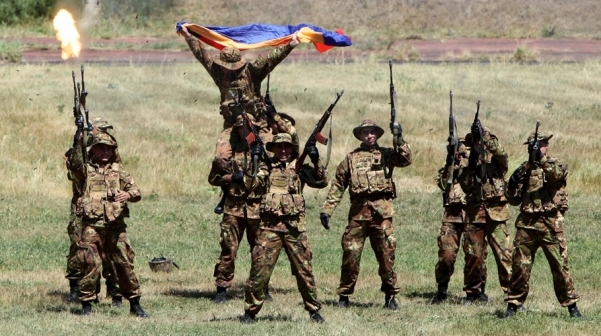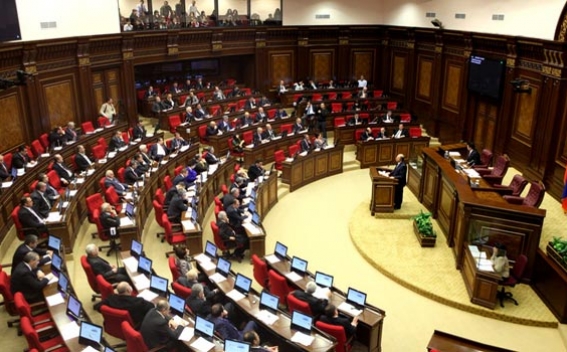While the clashes at the Armenia-Azerbaijan border “really” increase, both countries began to conduct extensive military drills. Though the acts that are performed in the drill scenarios are fictional, the number of casualties from both sides is real.
President of Armenia Serj Sarkisyan chaired the Armenia National Security Council meeting. This meeting was a part of the “Şant (lightning) 2015” drill which will test the strength of the command and control systems of the country if there is an attack.
One of the possible scenarios that were exercised is to evacuate the civilians from the “fictional” clash zone. According to this scenario, Sarkisyan was conducting the evacuation operation at the National Security Council meeting. And this is where the fiction ends.
On September 3, Serj Serkisyan had to deal with the “real” clashes between troops of Armenia and Azerbaijan, in addition to attending the military drill.
The most important drills
After the real clashes at the border, Azerbaijan conducted its own military drill as a response. According to the statement that came from Ministry of Defense on September 6, 65.000 military units, which is the whole military force of Azerbaijan, was put in action for the drill. 700 armed troops, 500 rocket units, 40 airplanes, 50 helicopters and 20 battleships were tested. This was the most extensive drill in the history of Azerbaijan and it was conducted without being announced in advance; Ministry of Defense hasn’t made any statement as to why this drill was conducted.
Similarly, “Şant 2015” is one of the most extensive drills in the history of Armenia. However, this was a rather political drill which tested the functionality of the government and officials in the state of war.
Armenian officials who participated in the drill also held a meeting with a group from Collective Security Treaty Organization (CSTO) which is a political-military organization that is led by Russia. Armenian Ministry of Foreign affairs performed a scenario in the drill that answers this question: “What happens if one of the CSTO partners does not discharge its responsibility?”, since it is thought that two Turkic allies in CSTO would support Azerbaijan if there is a conflict concerning the question of Karabakh.
Real Clashes
While the drills on both sides go on nonstop, media organs of both countries give coverage to the reports of causalities at the border. Though these reports are inconsistent with each other, it is true that the tension in that region increases. American co-chair of Minsk Group James Warlick made a statement on Twitter: “We are receiving reliable reports saying that both sides are shooting artillery that causes collateral damage. Increasing the tension is not the solution.”
Erivan states that this drill is not related to the increasing tension at the border. Deputy Chief of Armenian General Staff Movses Hakobyan said: “This drill was approved by our president on November 2014. This is an extensive drill that all the ministries participate; this is a first. It is too soon to make an evaluation, but we will share the results later.”
Tavuş is the region where fiction and reality is intertwined at its finest. Two countries blame each other for violating the truce in that region. People fear that the fiction will become reality.
Internal politics at the target
On the other hand, experts think that this drill-clash circle cannot be turned into a real war. Political scientist Alexander İskandaryan says, “If Azerbaijan were to carry a military operation, this would last a short time, maybe five days, and then the pressure of the world public opinion would begin. In such a case, Baku’s loss would be major; it can even lead to the resignation of Aliyev.”
In recent years, both countries rapidly increased the amount they use for the military spending. However, whereas Armenia has a 414 million dollars budget for military spending, Azerbaijan has 5 billion dollars. Despite this data, experts don’t expect a war. Firstly, they think that Azerbaijan doesn’t want to take Russia on by attacking Armenia. Secondly, Armenia can easily shot Azerbaijan’s oil and gas pipelines from its emplacements. Iskandaryan says, “The question of Karabakh is used as an instrument in the tense internal political environment in Azerbaijan.” With the decrease in the oil prices in the international market, Azerbaijan entered a period of economic slowdown. Security specialist Manvel Sargsyan also thinks that the tension will remain at the border and Azerbaijan will not intensify the clashes.
Armenia’s scenarios
- Armenia’s allies Kirghizstan and Kazakhstan support Azerbaijan in a state of war.
- During the war, there are thousands of civilians that must be evacuated from the clash zone.
- Important artworks that belong to Armenian cultural heritage should be transported to a safe place.





